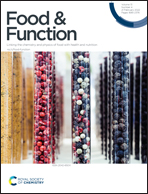Inhibitory effects of Atlantic cod (Gadus morhua) peptides on RANKL-induced osteoclastogenesis in vitro and osteoporosis in ovariectomized mice†
Abstract
Atlantic cod (Gadus morhua) is one of the most important fishes in the world with high nutritional value and economic value. However, the impact and underlying mechanism of the G. morhua peptides (GMPs) on osteoclastogenesis and bone mineral density (BMD) regulation remain unclear. The purpose of this study was to investigate the effects of GMPs on osteoclast formation and anti-osteoporosis activity in vitro and in vivo. The results showed that GMPs significantly reduced receptor activator of nuclear factor (RANKL) induced tartrate-resistant acid phosphatase (TRAP) activity, and decreased the expression of osteoclast regulatory factors c-Fos and NFATc1 by inhibiting the activation of MAPK and NF-κB pathways, and thereby inhibiting osteoclast formation and bone resorption. In vivo, GMP protects mice against ovariectomy-induced bone loss by regulating the balance of major factors released in bone formation and resorption. Taken together, GMP could be a potential candidate or dietary supplement for the prevention of osteoporosis.



 Please wait while we load your content...
Please wait while we load your content...